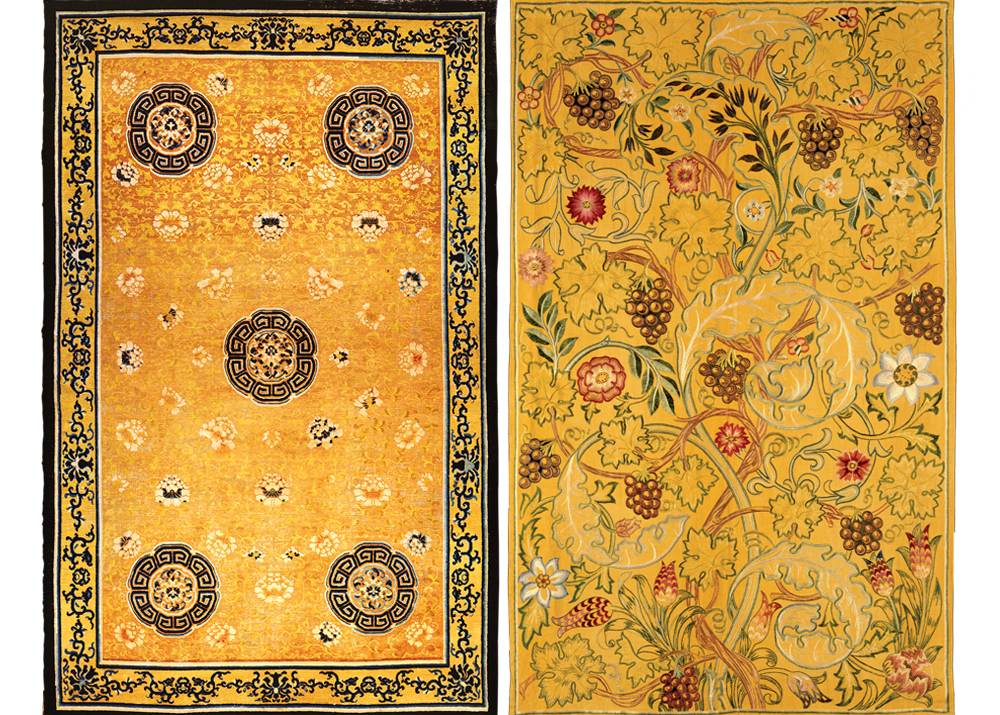Yellow shades from HALI 194
The regular HALI magazine feature Thread of Time takes an abstract look at the links between two intriguing textiles from different places and cultures that deserve to be in the limelight. The following is extracted from HALI 194: the Chinese edition. It compares the shade of yellow found on the Vine embroidered hanging by May Morris circa 1916—recently exhibited in ‘May Morris: Art and Life’ at the William Morris Gallery in Walthamstow—with that of the Goloubew five medallion dais cover from Ningxia in China dating to the Yongzheng period (1723-1735), which sold at Christie’s, New York in March 2017.
Embroidery pioneer May Morris (1862-1938) had clear opinions about how the colour yellow should be used alongside purple. Writing in 1892, she recommended a ‘purple very dusky and dead in tone and yellow clear and fresh; the least tendency to a “buttery” shade on the one hand and a hot red purple on the other makes the most ingeniously hideous admixture of colour possible to imagine’.
The youngest daughter of William Morris, May had plenty of experience in colour selection, having assisted in colouring the patterns for rugs produced by her father’s firm, Morris & Co. There, she championed natural dyes and took control of the embroidery department at the age of twenty three. Embroidery kits and design books were an important part of her department’s output and the Vine design by William Morris appeared as a door hanging in muted blues and greens in the Embroidery Work catalogue from around 1912. This colourway was intended to meet the demand for fashionable recreations of 17thand 18th-century woollen crewelwork, but May’s vibrant interpretation takes a 20thcentury departure from the historic style referenced, and it is likely that this was the piece recorded as being shown at the 1916 Arts and Crafts exhibition at London’s Burlington House.

In 1911, the rug illustrated here appeared in the first ever exhibition of Chinese carpets at the Musée Cernuschi in Paris, when it belonged to the Russo, French archaeologist and Orientalist Victor Goloubew (18781945). Curated by the museum’s director Henri d’Ardenne de Tizac, the show took place just as importers and collectors in the west were beginning to note the beauty and importance of Chinese carpets. The museum archives report that 108 recent acquisitions of ‘tapis de Pékin et du Turkestan’ from private collections were loaned for the occasion.
By the time such carpets received attention in Paris, their original colour was already much altered. Construction of the Great Palace in Beijing began in the early 15th century. Many carpets made for the halls of the Forbidden City had red grounds, as shown in scroll paintings of Kangxi Emperor and his Ming predecessors. Although the earliest of these remained on the floors of the principal halls for three centuries, their thick, lush pile was only ever walked upon with silk slippers, so they do not show significant signs of wear. However, oxidisation changed the colour of the wool significantly, something clearly demonstrated by darker patches on examples where a screen or platform has rested in one position for many years, revealing the original red shade underneath.
By the dawn of the European chinoiserie craze in the first decades of the 20th century, the carpets would have already faded to a beige or tan, leading to the widespread assumption that this was their intended shade. They gained appreciation in this light in their country of origin too, and when reproductions were made for the throne platforms in the Hall of Supreme Harmony and the Palace of Heavenly Purity in the 1960s and 1970s, a synthetic yellow emulating the faded natural red was used. Whether their dominant colour was due to the passage of time or a careful choice, the display of these two textiles in the 1910s is bound to have influenced taste in the century that followed.























Comments [0] Sign in to comment